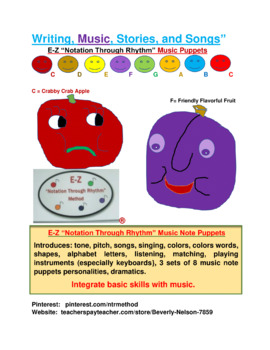MUSIC PUPPETS - "Writing, Music, Stories, and Songs"
- PDF
Description
"Writing, Music, Stories and Songs" introduce the eight, unique, fun, learning Music Puppets. Considered a music readiness program similar to our familiar readiness materials used in pre-reading, pre-math, and language development. It is an introductory, socialization program which combines fun and environment for motivation and learning. Methods introduce the Key of "C" Scale via colors, tones, letters, foods, and 3 sets of cartoon character puppet-dolls: 1. Paper Bag, 2. Tall , and 3. Finger or Stick Puppets. The E-Z "Notation Through Rhythm" International Standard Music Color Code is used for this inexpensive, productive approach to music education and motivation.
It is easy to introduce each puppet at circle time where the teacher using a small, electronic keyboard can hold it up for the children to see the color coded marked keyboard and her/his fingering. At first, for each puppet introduce their one note song, played, sung and observed. Many basic, important early learning skills are involved besides learning the note and placement on keyboard and scale. Color recognition and use of, alphabet letters, shapes, tones, pitch, listening, singing, matching, color words (which is the beginning of reading), auditory perception, visual perception, eye-hand coordination, left to right progression, and the beginning of learning and playing familiar and unfamiliar songs on an instrument. And if you get the "Writing, Music, Stories, and Songs" 4 Composing Methods Offer it extends learning to original compositions, vocabulary, music fundamentals, creativity, rhythm, and much more.
Children and beginners want to be able to play familiar tunes immediately. They want success, not struggles or boredom over what seems to be trivial. Keyboards and instruments need to make music, not noise. The method advances beyond puppets and color to colored scores, composing original tunes, then traditional scores. See other "Writing, Music, Stories and Songs" Offers such as: Introduction to "Writing, Music, Stories, and Songs" - 4 Composing Methods -Rhythm Bands- Rhythm and Movement - and E-Z Keys Removable Note Scales.
Most environmental learning enrichment materials facilitate language, reading and writing readiness. And although songs are included little has been done in the area of music notation, theory, and tone readiness. What has been done lacks familiarity, color, is abstract and being unused is easily forgotten. The E-Z "Notation Through Rhythm" Methods break from tradition to benefit not only the talented, but the lonely, the bored, the curious, the self-discoverers, and all levels of learning.
Young students are capable of the E-Z Keys, E-Z "Notation Through Rhythm" Methods, and when properly introduced, respect and care for the instruments. I like to have a small, electronic keyboard for each circle time youngster. Keyboards should have a pleasant tone, and loudness should be adjustable. Earphones and also microphones may also be available for some models.
At first students do not need the Bass for playing, but it is good if eventually the keyboards have both the Treble and Bass octaves.





